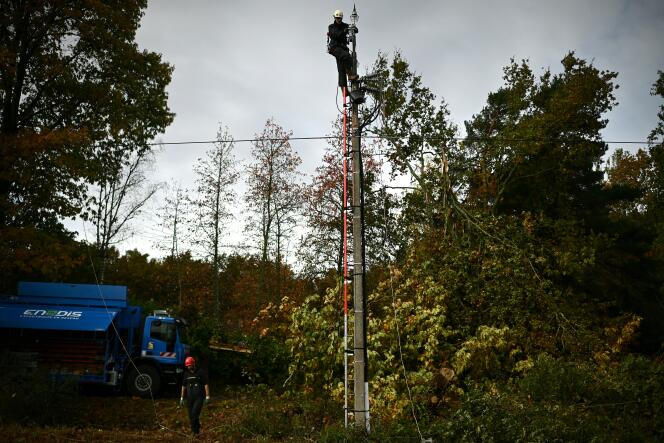A week after the passage of storms Ciaran and Domingos, a little more than 450,000 French people were still having difficulty making calls with their mobile phones, three-quarters of whom were in Brittany, mainly in Finistère, and in Normandy, according to the countdown from November 7 in the evening of the French Telecoms Federation (FFT), the professional association of the sector. This is a little more than half the peak recorded on November 2. In landlines, the FFT still recorded 74,000 homes disconnected, or six times fewer than at the height of storm Ciaran.
According to the latest projections, 90% of mobile customers should be restored by the end of this week. In the fixed sector, the work may take longer. Orange, the leading French telecoms operator, on which a very large part of the fixed network depends, plans to double, to 6,000, the number of technicians in the field to work on restoring service. Reinforcements were called from neighboring regions.
Several thousand poles, on which the copper wires of the network but also fiber optic lines run, are on the ground. Cables were cut by falling trees or branches. Some more solid equipment, such as connection centers, were flooded or damaged. The heaviest repairs could take several months.
Electrical weakness of networks
Exceptional and necessarily more impactful than previous major storms – France currently has 80 million mobile plans compared to 14 million at the end of 1999, at the time of Lothar and Martin – these two meteorological events nevertheless revealed the vulnerability of telecoms networks and the potentially serious consequences of prolonged inaccessibility. “A lot of things now rely on telecoms, starting with emergency calls which, when the mobile network is cut, no longer come through”underlined Jean-Noël Barrot, the Minister of Digital Transition and Telecommunications, during a trip, on November 6, to Finistère, with the leaders of telecom operators and Enedis, the manager of the public distribution network of electricity.
If the fixed network still relies heavily on overhead lines, which makes it vulnerable, for mobile it is not the wind resistance of antennas installed on building roofs, water towers or at the top of pylons metal which is involved. Almost all of this equipment did not suffer from the storms. The Achilles heel of the mobile network lies in the power supply: in the event of a power outage, as was the case last week, the antennas no longer transmit. As a result, subscribers close to this equipment find themselves without a signal. Some pylons sometimes host the four major operators (Orange, SFR, Bouygues Telecom and Free), the absence of network can be total.
You have 50% of this article left to read. The rest is reserved for subscribers.
